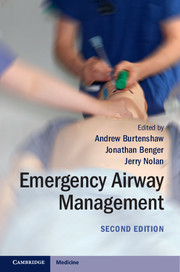Description
Emergency Airway Management (2nd Ed.)
Coordinators: Burtenshaw Andrew, Benger Jonathan, Nolan Jerry
Thoroughly updated to reflect best current practice, this book guides the trainee through every aspect of a challenging clinical scenario.
Language: English
Subject for Emergency Airway Management:
Publication date: 03-2015
217 p. · 12.3x18.6 cm · Paperback
217 p. · 12.3x18.6 cm · Paperback
Description
/li>Contents
/li>
From principles of oxygen delivery and patient assessment, through rapid sequence induction of anaesthesia and tracheal intubation, to the difficult and failed emergency airway, this book from an expert team of clinicians guides the reader through every aspect of emergency airway management. Retaining the concise, accessible format of the first edition, it includes a new section on human factors and improving teamwork and performance, an expanded special circumstances section, and a summary of the 4th National Audit Project of the Royal College of Anaesthetists and Difficult Airway Society and its implications for practice. Updated guidelines, new technologies such as videolaryngoscopy, and recent evidence have all been incorporated into the chapter content, ensuring that the book reflects best current practice. This thoroughly updated new edition remains an essential resource for navigating a highly challenging clinical scenario and will be of value to emergency medicine, intensive care, anaesthesia and acute medicine clinicians.
1. Introduction Andrew Burtenshaw, Jonathan Benger and Jerry Nolan; 2. Delivery of oxygen Carl Gwinnutt; 3. Basic airway management Stephen Bush and David Ray; 4. Indications for intubation Colin Graham and Dermot McKeown; 5. Airway assessment Dominic Williamson and Jerry Nolan; 6. Preparation for rapid sequence induction Simon J. A. Chapman and Les Gordon; 7. Pharmacology of emergency airway drugs Shirley Lindsay and Jonathan Benger; 8. Rapid sequence induction and tracheal intubation Jonathan Hulme and Dinendra S. Gill; 9. Difficult and failed airway Dermot McKeown and Gavin Lloyd; 10. Post-intubation management Paul Younge and John C. Berridge; 11. Emergency airway management in special circumstances: a. Paediatrics Patricia Weir and Paul Younge; b. Trauma and raised intracranial pressure Jonathan Hulme and Dinendra S. Gill; c. Cardiorespiratory Gavin Perkins; d. Non-traumatic coma and seizures Carl Gwinnutt; e. Pre-hospital care Jonathan Benger; f. The pregnant patient John Clift; 12. Non-invasive ventilatory support Dinendra S. Gill and Gavin Perkins; 13. Human factors Andrew Burtenshaw, Colin A. Graham and Kevin Fong; Appendix 1. Mnemonics; Appendix 2. Emergency airway algorithms; Appendix 3. Example intubation checklist; Appendix 4. NAP4 summary Tim Cook, Nick Woodall, Chris Frerk and Jonathan Benger; Index.
© 2024 LAVOISIER S.A.S.
These books may interest you

Core Topics in Airway Management 95.29 €

Paediatric Anaesthesia 81.47 €


